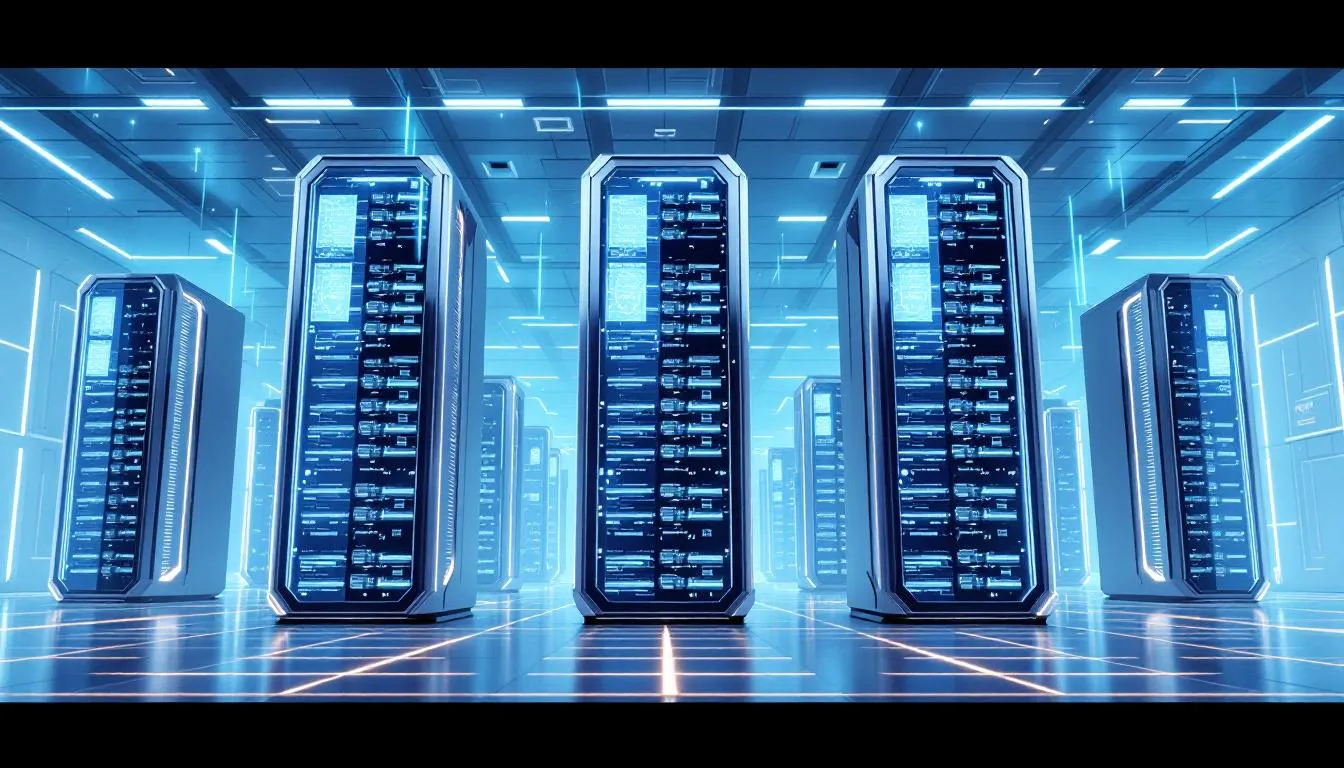Curious about different data center examples? In this article, we’ll dive into various data center models like enterprise, colocation, hyperscale, and edge data centers. You’ll find real-world examples and learn about their unique features and benefits.
Key Takeaways
- Enterprise data centers provide enhanced security and performance for organizations, exemplified by JPMorgan Chase’s facilities designed for financial transactions.
- Colocation data centers allow businesses to share resources, offering retail, wholesale, and managed services options that enhance scalability and cost-effectiveness.
- Hyperscale and edge data centers are crucial for modern cloud services and IoT applications, providing the necessary infrastructure for rapid data access and reduced latency.
Enterprise Data Centers: Real-World Examples

Enterprise data centers are private facilities owned and operated by large organizations to meet their specific IT needs. These centers support a single business or organization, ensuring that all data storage, processing, and management are handled in-house. This model is particularly beneficial for organizations that require enhanced security, superior performance, and strict regulatory compliance, such as financial institutions and healthcare providers.
An excellent example of an enterprise data center is JPMorgan Chase’s data centers. These facilities are meticulously designed to manage and secure global financial transactions, providing a robust and reliable backbone for one of the world’s largest financial institutions. This exemplifies the heavy investment in space, infrastructure, and maintenance required to operate an enterprise data center effectively.
Colocation Data Centers: Shared Space Solutions

Colocation data centers offer businesses the opportunity to outsource their IT operations by renting space in a shared facility. This model enhances scalability and cost-effectiveness by allowing multiple organizations to share space and resources in a colocation data center and multi tenant data centers.
Colocation data centers are divided into three main types of data centers: retail colocation facilities, wholesale colocation facilities, and managed services colocation.
Retail Colocation Facilities
Retail colocation facilities provide turn-key data center services for businesses with smaller power needs, typically ranging from 100 kW to 1 MW. These facilities are ideal for small to medium-sized enterprises that require reliable IT infrastructure without the overhead of maintaining their own data centers. Examples of retail colocation providers include Equinix, CoreSite, and Cyxtera, known for their robust service offerings and strategic locations.
In retail colocation facilities, day-to-day business operations are managed by the data center operator, allowing businesses to focus on their core activities while ensuring their IT needs are met. Contracts for these services usually last between one to three years, providing flexibility and scalability for growing businesses.
Wholesale Colocation Facilities
Wholesale colocation facilities cater to larger organizations that require significant space and power. These facilities offer substantial data center space and power capacities, often at reduced rates, making them a cost-effective solution for enterprises with extensive IT needs. Notable companies providing wholesale colocation services include Digital Realty, CloudHQ, and STACK Infrastructure, which are renowned for their large-scale operations and high reliability.
These existing facilities are designed to support a single customer per space, providing a dedicated secure environment that ensures optimal performance and security. This model is particularly beneficial for cloud service providers and large enterprises that demand extensive computing and storage systems capabilities.
Managed Services Colocation
Managed services colocation goes a step further by offering comprehensive IT infrastructure management, telecommunications infrastructure, and network infrastructure. Providers handle all aspects of IT operations, from maintenance to security, allowing organizations to focus on their core business functions. This model is ideal for businesses looking for a hassle-free solution to manage their managed services data centers efficiently.
Examples of managed services colocation providers include Flexential and TierPoint, both known for their extensive service offerings and high levels of customer support. By leveraging these services, businesses can ensure effective infrastructure management without the need to invest in and maintain their own data centers.
Hyperscale Data Centers: Giants in the Industry

Hyperscale data centers are the behemoths of the data center industry, characterized by:
- Size ranging from 50,000 to over 1 million square feet
- Custom-built design to meet extensive computing and storage needs of cloud service providers
- Power capacities ranging from 5 to 100 megawatts
- Construction costs that can exceed $1 billion, reflecting their scale and complexity
The global hyperscale data center market is booming, with predictions indicating growth from $35.72 billion in 2022 to $76.73 billion by 2027. These data centers are strategically located on the outskirts of major cities to optimize power usage and location efficiency, accommodating the vast data requirements of today’s digital economy.
Major Hyperscale Data Centers
Major hyperscale data centers serve as the foundation of cloud regions and availability zones, ensuring that cloud services are always available and reliable. These facilities are designed to optimize power usage and location efficiency, providing a robust backbone for cloud service providers like Google Cloud, AWS, and Microsoft Azure.
These new data centers are not just large data centers but also technologically advanced, incorporating the latest innovations in cooling, power management, and security to handle all the data from the immense data loads they process data daily. By supporting multiple organizations and multiple data centers, they play a crucial role in the global data center’s term data center infrastructure and optimize data center resources.
Edge Data Centers: Proximity Matters

Edge data centers are smaller, decentralized facilities strategically located close to data sources to reduce latency and improve real-time data processing. These edge data center are essential for applications that require rapid data access and minimal delay, such as 5G and Internet of Things (IoT) technologies.
Located closer to users, edge data centers ensure faster data transmission and enhanced performance, providing direct access and making them crucial for modern digital services demanding low latency, high speed, and network connectivity.
Notable Edge Data Centers
Notable edge data centers include metro edge facilities and mobile edge data centers, each designed to meet specific operational needs. Metro edge facilities typically support power capacities ranging from 100 kW to 500 kW, providing robust infrastructure for urban areas. On the other hand, mobile edge data centers support power capacities of up to 100 kW, offering flexibility and rapid deployment capabilities.
These edge data centers are pivotal in reducing latency and enhancing data processing capabilities, ensuring that digital services are fast, reliable, and efficient through edge computing.
Modular Data Centers: Flexible and Scalable
Modular data centers are designed to be flexible and scalable, reducing the time and cost required for construction and deployment. Key features include:
- Portability, allowing for quick scalability and flexible deployment to meet varying operational needs.
- Cost savings through standardization and reduced on-site labor.
- Popularity across various environments due to these advantages.
Often deployed in construction sites, disaster areas, and to accommodate new technology, modular data centers represent an innovative solution in the data center industry.
Container Data Centers
Container data centers integrate facility structure, IT equipment, data center equipment, power, and cooling systems into standardized units, supporting IT capacity ranges from 20 kW to 250 kW. Their modular nature allows for the adjustment of IT capacity to meet varying power needs, providing a versatile solution for different data processing requirements.
These data centers are ideal for temporary IT capacity needs and can be quickly configured and deployed, ensuring that data processing capabilities and computing resources are always available when needed.
Prefabricated Data Halls
Prefabricated data halls facilitate the rapid addition of white space to existing data centers using pre-manufactured components. These halls typically occupy several thousand square feet and can support 50 to 200+ racks, providing a scalable solution for expanding data center capacity.
Prefabricated Power and Cooling Modules
Prefabricated power and cooling modules are pre-engineered systems designed for rapid deployment and installation, with power capacity ranging from 250 kW to 2 MW.
These modules ensure reliable power and efficient cooling, making them essential key components of modern data center components in data centers.
Unique Data Center Projects Around the World

Unique data center projects around the world showcase innovative designs and technologies that enhance flexibility and scalability. Modular data centers, for instance, are designed to be portable and suitable for rapid deployment in various environments, making them ideal for urgent situations like disaster recovery.
Green Data Centers
Green data centers are at the forefront of sustainable data center design, focusing on energy efficiency and environmental impact. Innovative designs include underwater facilities that utilize ocean water for cooling, significantly reducing energy consumption. Google is also developing advanced cooling technologies aimed at minimizing water usage in their data center operations.
Many green data centers harness solar energy to power their operations, dramatically reducing their carbon footprint. These centers often feature unique architectural designs that enhance energy efficiency and operational effectiveness.
High-Density Data Centers
High-density data centers are designed to support high-density computing environments, optimizing space and power usage. These centers utilize space-saving technologies, allowing for the deployment of more servers in a smaller footprint, which optimizes power and cooling efficiency.
Disaster-Resilient Data Centers
Disaster-resilient data centers incorporate the following strategies:
- Strategic location to avoid natural disaster-prone areas, integrating risk assessments during site selection.
- Design strategies like base isolation and flexible materials to absorb seismic shocks, enhancing resilience in earthquake-prone regions.
- Flood-resistant measures, such as waterproof entrances and elevated server placements, to protect critical equipment from water damage.
Advanced technologies and smart sensors can enhance disaster response and maintenance in data centers, ensuring long-term resilience. Establishing multiple power sources and diverse connectivity paths is essential to maintain operations during natural disasters, particularly with the integration of emerging technologies, artificial intelligence, and security systems.
Data Center Performance Metrics
Power Usage Effectiveness (PUE) is a key metric indicating the energy efficiency of a data center, calculated by dividing total facility power by IT equipment energy usage. A lower PUE value, ideally between 1.3 to 1.0, signifies more efficient energy delivery in a data center, contributing to overall operational efficiency and cost efficiency. The Green Grid, an industry consortium, developed the PUE metric to help organizations benchmark data center energy efficiency.
Data center infrastructure management (DCIM) software can automate PUE calculations by collecting real-time energy consumption data, making it easier to monitor and improve energy efficiency. Advanced cooling techniques, such as liquid cooling, are also being implemented to significantly reduce energy consumption compared to traditional air cooling methods.
Choosing the Right Data Center Solution
Choosing the right data center solution is vital for ensuring that your IT infrastructure is secure, scalable, and cost-effective. The average cost of a cyber attack on data centers is around $4 million, highlighting the importance of security in selecting a data center provider. Prefabricated data halls can significantly speed up the expansion process for existing data center facilities, providing a scalable solution for growing businesses.
Container data centers, which can be quickly configured, are often used for temporary IT capacity needs, ensuring that data processing capabilities are always available when needed. Selecting a data center location near your business can improve performance by reducing latency and enhancing data transfer speeds.
Summary
The world of data centers is vast and varied, offering solutions to meet diverse IT needs. From enterprise data centers to modular and green data centers, each type has its unique features and benefits. Understanding these differences is crucial for selecting the right data center solution that aligns with your organization’s goals and requirements.
As technology continues to evolve, data centers will remain at the heart of digital transformation, driving innovation and efficiency. By choosing the right data center solution, businesses can ensure robust and reliable IT infrastructure that supports their growth and success.
Frequently Asked Questions
What are enterprise data centers?
Enterprise data centers are privately-owned facilities utilized by large organizations to address their unique IT requirements, prioritizing security and compliance.
What is the difference between retail and wholesale colocation facilities?
Retail colocation facilities cater to smaller power requirements with ready-to-use services, whereas wholesale colocation facilities offer larger space and power options at lower rates for single customers.
Why are hyperscale data centers important?
Hyperscale data centers are vital because they efficiently support the immense computing and storage demands of cloud service providers, which are essential for the functioning of the global data infrastructure. Their scale enables enhanced performance and reliability for various digital services.
How do edge data centers reduce latency?
Edge data centers reduce latency by being situated near data sources, allowing for faster data transmission and real-time processing. This proximity enhances overall performance and user experience.
What are the benefits of modular data centers?
Modular data centers offer flexibility and scalability, significantly reducing both construction time and costs while allowing for quick configuration to adapt to changing operational requirements. This makes them a highly efficient solution for modern data management needs.
